TechRadar Verdict
Lenovo has crafted a brilliant, forward-thinking device that could very well create a subcategory in computing all of its own. But, with low-power components inside holding it back against the tablet competition, it’s tough to outright recommend you buy the first generation.
Pros
- +
Insanely thin and light
- +
Halo Keyboard surprisingly accurate
- +
Excellent display
- +
Clever Create Pad
Cons
- -
Woefully underpowered
- -
Dated microUSB port
Why you can trust TechRadar
We’re lucky to live in a world where the Lenovo Yoga Book exists, and we’re not just saying that because it’s remarkably affordable. No, the Lenovo Yoga Book is worth your attention because it’s the unlikely combination of a tablet and a laptop in a way we’ve never seen before.
Even though the Lenovo Yoga Book is one of the best 2-in-1 laptops, it doesn’t have a physical keyboard – at least not like you would think. The Lenovo Yoga Book instead uses a unique hinged keyboard and trackpad completely without travel – it’s totally digital. That may sound awkward and difficult to get used to – and it is.
The Lenovo Yoga Book is still worth your time in 2018, especially with the low cost – which we’ll explore here in a minute. But its inputs separate from the screen, usable as a WAcom digitizer is a definite plus. Of course, cooking up a unique, never-before-seen laptop is a full-time job, and we wouldn’t advise writing off the Yoga Book. After all, breaking new ground will always take some getting used to.
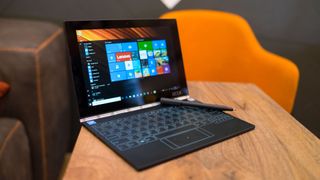
And finally, this is the first laptop or tablet to come in both Windows 10 and Android varieties using the exact same hardware inside.
That’s quite a lot of firsts for a 10.1-inch productivity device that costs just $499 (about £409, AU$655; Android) or $549 (about £450, AU$720; Windows 10) to start. There has to be a catch, right?
There’s always a catch, but this unique notebook is still popular here at TechRadar, having made it onto our list of the best laptops. So, let’s dive into everything that makes the Lenovo Yoga Book such a great device.
Design
The Yoga Book, at first glance, looks like every other Lenovo Yoga laptop – only smaller. The impressive, gorgeous watchband hinge first introduced with the Yoga 3 is present and correct, and the insanely thin device is wrapped in a smooth, luxurious magnesium alloy shell like so many Yoga devices before it.
The Android edition of the Lenovo Yoga Book, which we’d guess Lenovo expect to sell more, comes in Champagne Gold, Carbon Black and Gunmetal Gray finishes. The Windows 10 edition just comes in Carbon Black – but all of these finishes look fantastic.
[Editor’s Note: This review focuses on the Windows 10 version of the Yoga Book, with salient differences in the Android Marshmallow version noted.]
A power button and volume rocker on the device’s right side are edged in chrome, and speakers sit behind dotted grilles on either side of the keyboard deck. The speakers pump out suitable range and volume despite their size, thanks to Dolby Atmos technology inside.
Another impressive feature about the Yoga Book despite its size is the 10.1-inch, 1,920 x 1,200 resolution screen. With 400 nits of brightness and the capability to display a range of 16.7 million colors, HD movies look excellent on the Yoga Book, and in-plane switching (IPS) means wide angles for screen sharing.
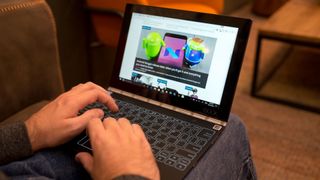
Tactile touch typing
If you’re doubting whether you can effectively type on an entirely digital, capacitive keyboard, don’t worry. In our time with both versions of the Lenovo Yoga Book and its Halo Keyboard, it was shockingly easy to type accurately without any kind of physical feedback or buttons.
Sure, there’s haptic feedback and audio cues that signal when typing, like on a smartphone, which can be toggled on or off. But, neither completely account for how accurate we are typing on this backlit digital keyboard, behind a sheet of Gorilla Glass with individually lit keys.
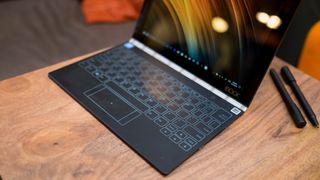
If anything, our accuracy is testament to our growing aptitude with digital keyboards since the dawn of smartphones and tablets – only this one doesn’t take up half the screen. (Lenovo’s patent-pending hardware and software helps a great deal here, too.)
Even without auto-correct software on the Windows 10 version, we found ourselves making very few errors while working on the Yoga Book. Of course, it’s unrealistic to expect the same words-per-minute speed that you would attain on an analog keyboard, and we don’t expect everyone to have the same easy transition that we had. The Android version’s Lenovo-made TouchPal auto-correct software should help a great deal with that acclimatisation.
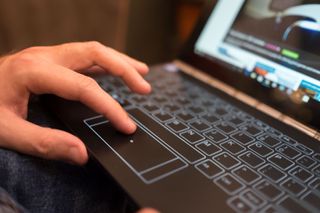
This, then, brings us to a question: if all versions of Windows 10 are essentially the same operating system (OS), why then is Windows 10 Mobile’s excellent auto-correct software not available on all versions of the OS?
As for the Android version, we in fact not only found the built-in auto-correcting software to be extremely helpful, but practically essential after getting used to it being there.
However, in order for said keyboard to work properly, we had to disable all international keyboards. Otherwise, certain key presses would register whatever the key is next to it on-screen. At least this workaround solved the issue.
At any rate, we found navigating and typing on the Yoga Book surprisingly easy after about an hour with the device. Of course, you’ll find differences between both keyboards – i.e. the Windows 10 version’s left and right mouse buttons that allow for click-and-drag and the Android version’s lack thereof – but both offer the same fidelity.
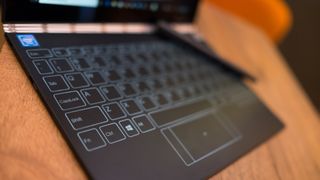
The Wacom digitizer is wonderful
It’s fine enough that the Yoga Book is the first laptop or tablet to include a keyboard that doubles as a full-blown Wacom digitizer. It’s even better that the tool is a joy to use, not to mention that it has one super-neat trick up its sleeve.
Pressing and holding a capacitive button above the keyboard with a pen icon switches the tool from displaying the keys to displaying, well, nothing but an illuminated pen icon. This means you can now use the surface to draw or write with the included Real Pen stylus.
Lenovo calls this the Create Pad, a layer of electromagnetic resonance (EMR) film beneath the keyboard that’s powered by Wacom Feel technology. This means that the Real Pen needs nothing inside to operate, with the Create Pad doing all of the work – even the 2,048 levels of pressure sensitivity.

The Create Pad offers the supreme palm detection artists have come to expect from the brand, and has differing levels of support from the Yoga Book depending on the version. The Windows 10 version supports the Create Pad in all apps that would support stylus control, like Windows Ink, but specifically calls up OneNote when activated.
On Android, however, Lenovo seems to have enjoyed a lot more freedom in custom-tailoring software for the OS, with Lenovo’s home-grown Note Saver app for note-taking and drawing.
Regardless, both versions of the Yoga Book are capable of one aforementioned, seriously cool trick: taking scrawlings in pen on paper and digitizing them for later access, editing and backup. This is made possible through an included magnetic notepad that attaches itself to the Create Pad’s surface, and included (office-standard) real-ink ballpoint tips for the Real Pen.
Now, this is where the EMR comes into play. As soon as the Real Pen touches the notepad – when attached to the Create Pad surface – whatever’s written is picked up by the electromagnetic response given off by the contact of pen to paper through the notepad’s magnetic rear surface, to be translated onto the screen via the Create Pad. The accuracy with which this is achieved is incredible, and it’s something you simply have to see in action yourself to believe.
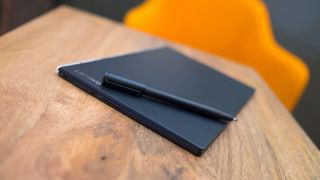
With this feature, you can even fold the tablet in the reverse direction to use it simply as a traditional paper notepad with a digital backup. Using the tablet in this way even shuts the screen off, saving precious battery life – though, the Yoga Book already has gobs of that.
But, beyond note-taking, we could see this feature being a boon for artists that feel more at home drawing on paper with ink than a glass surface with a stylus, with the option to alter their work digitally later. Of course, this assumes a lot on the front of app and file compatibility.
All told, the Yoga Book’s Create Pad and Halo Keyboard are wowing tools that separate this tablet from the majority of 2-in-1 devices. Even more so, they stand to see Lenovo spur yet another standard in dual-purpose computing devices.
But before we get ahead of ourselves, let’s see how this thing stacks up against some of the leading tablets, and what it’s like to use as a productivity device.
- You could save on Lenovo products with our Lenovo promo codes.
Joe Osborne is the Senior Technology Editor at Insider Inc. His role is to leads the technology coverage team for the Business Insider Shopping team, facilitating expert reviews, comprehensive buying guides, snap deals news and more. Previously, Joe was TechRadar's US computing editor, leading reviews of everything from gaming PCs to internal components and accessories. In his spare time, Joe is a renowned Dungeons and Dragons dungeon master – and arguably the nicest man in tech.

